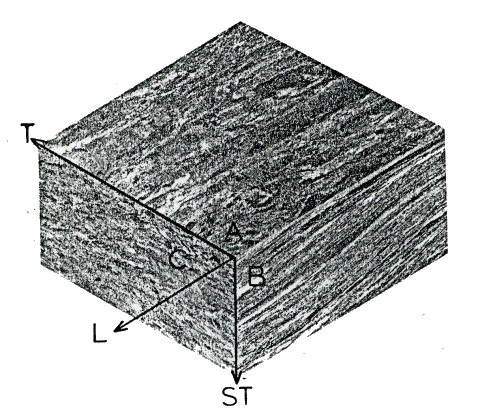Titanium
Titanium alloys are used for resonators with high stress, resonators that must meet biological compatibility requirements, resonators that must resist chemical attack, and resonators that must have moderate resistance to impact, wear, and cavitation erosion. Applications include medical (surgical), plastic and metal welding, liquid processing, and food packaging and cutting.
Properties
Orthotropic
Titanium is orthotropic, which means that the material properties (modulus of elasticity and Poisson's ratio) depend on the direction in which the material is tested with respect to the grain direction. The grain directions are commonly labeled as longitudinal L (i.e., parallel to the grain), transverse T (also called long transverse LT), and short transverse ST. See the following figure from Bowen[1], p. 1273.

Grain direction in Ti‑6Al‑4V
(Longitudinal,
Transverse,
Short
Transverse)
Bowen[1] (p. 1272) lists the following properties for this material. Note the substantial dependence on the test direction.
| Testing Direction |
0.2% Proof Stress (MPa, psi) |
Tensile Strength (MPa, psi) |
E (GPa, psi) | C0
(m/sec, in/sec) |
Fatigue Strength (MPa, psi) |
| Longitudinal (L) | 834 (121.0e3) |
910 (132.0e3) |
113.9 (17.5e6) | 5070 (199620) |
496 (72e3) |
| Transverse (T) | 934 (135.5e3) |
986 (143.0e3) |
129.0 (18.7e6) | 5398 (212510) |
427 (62e3) |
| Short transverse (ST) | 893 (129.5e3) |
979 (142.0e3) |
113.9 (17.5e6) | 5070 (199620) |
565 (82e3) |
Table notes:
- The material is Ti‑6Al‑4V, forged and annealed, 235 mm (9.25") wide x 57 mm (2.25") thick .
- The original table values were Imperial (those in parentheses).
- The fatigue strength is approximate at 107 cycles.
- The thin wire wave speed C0 is calculated as √(E/ρ) where the assumed density ρ is 4430 kg/m3 (0.160 lbm/in3). These C0 values were not included in the original table.
For titanium the wave speed depends on the following factors:
- The direction of vibration with respect to the grain direction (see the table).
- The position along the length of a bar.
- The heat from which the sample was produced. Variations may also occur from different samples of the same heat.
- The raw stock type (rod, bar, sheet, or plate).
- For rod material, the raw stock diameter (see below).
Thus, because the wave speed or modulus of titanium may not be precisely known, the tuned length of a titanium resonator will not be entirely repeatable and may not be precisely predicted, even using computer simulation.
Loss (Q)
DRC data; Wuchinich data
Variation with grain direction
Limited experimental data indicates that the loss depends on the vibration direction relative to the grain. xxx
Fatigue characteristics
xxx Fatigue strength; fatigue knee; grain direction
Ti‑6Al‑4V (ASTM grade 5)
When a titanium alloy is required, Ti‑6Al‑4V (6% aluminum, 4% vanadium) is most commonly used because it is widely available in many forms. Also, because this alloy is widely used for non-ultrasonic applications (particularly aerospace), a huge knowledge base has been compiled. Also, Ti‑6Al‑4V is approved in the U.S. and other countries for ultrasonic surgical devices.
Variation of wave speed with diameter
xxx
Data scatter
xxx
Poisson's ratio
A wide range of values have been reported for Poisson's ratio. These values are affected by the same factors as the wave speed and modulus (above).
- "It is difficult to give a reliable value for Poisson's ratio for titanium alloys since anisotropy leads to small differences in both elastic and shear moduli which, when taken together to calculate Poisson's ratio, can lead to values varying from 0.287 to 0.391 for annealed ASTM Grade 5 (Ti-6%Al-4%V) sheet. However, the generally accepted value for commercially pure titanium is 0.36 and that for ASTM Grade 5 is 0.31."[2]
- STA condition (solution treated 900-955ºC, aged 540ºC): Poisson's ratio = 0.33[3]
- Annealed condition: Poisson's ratio = 0.342[4]
- "Poisson's ratio depends on material texture and measurement directions. Ten observations at TIMET, using a two element rosette strain gage, gave a mean value of 0.342 with a range of observations from 0.287 to 0.391."[5]
- xxx my tests
Ti‑7Al‑4Mo
Branson uses Ti‑7Al‑4Mo (7% aluminum, 4% molybdenum), typically from TIMET.
Machining
xxx When available, carbide tools are recommended.
References
- A. W. Bowen, "The Effect of Testing Direction on the Fatigue and Tensile Properties of a Ti‑6Al‑4V Bar", Titanium Science and Technology, R. I. Jaffee and H. M. Burte (editors), Plenum Press, New York, 1973, pp. 1271 - 1281.
- Azo Materials, "Titanium Alloys - Physical Properties"
- Aerospace Specification Metals Inc. (Web site: "Information provided by Allvac and the references.")
- Aerospace Specification Metals Inc. (Web site: "Information provided by Allvac and the references.")
- "Properties and Processing Ti‑6Al‑4V", TIMET, 1986, p. 15